One Acre at a Time
How Ducks Unlimited delivered a record 1 million acres of conservation in the past year
How Ducks Unlimited delivered a record 1 million acres of conservation in the past year

Jay Volk can stand near the southwest corner of the pasture and see it all come together on a single acre of his ranch. Thirty-five miles north of Bismarck, North Dakota, in the famed Prairie Pothole Region, a small ephemeral wetland glistens with the year’s spring rains. The shallow pond is ringed with sedge and horsetail. Along its edge, the fringe of lush wetland plants gives way to a rise of western wheatgrass, needle-and-thread, and big and little bluestem. Just beyond, hummocks are clad in buckbrush and purple prairie clover, prairie rose, and prairie smoke.
Mallards and gadwalls regularly nest around the wetland, which is situated on the edge of the rolling knolls of the Missouri Coteau—a broad band of high-priority habitat that supports some of the highest densities of breeding ducks in North America. Volk has watched Hungarian partridge and ring-necked pheasants raise broods near the pothole. There are even a few sharp-tailed grouse leks close by, where the birds gather to dance and attract mates.

It’s all there because Volk recently installed nearly 10,000 feet of new barbed-wire border and cross fencing with the help of Ducks Unlimited and the USDA Natural Resources Conservation Service. The fencing allows Volk to rotate his cattle from pasture to pasture to prevent overgrazing. That encourages wetland and prairie plants to thrive, prairie potholes to fill and hold water, grassland birds to raise their nestlings, and ducks to call the Volk Ranch home. It’s a single acre, but it is connected to another quarter-section of pasture, which abuts another 500 acres Volk hopes to bring under stewardship as well.
And that makes it an important part of one of Ducks Unlimited’s most significant achievements. At DU’s 87th National Convention, CEO Adam Putnam announced that, for the first time in the organization’s history, DU had delivered 1 million acres of conservation across the United States in a single year. Each of the tallied projects was completed between July 1, 2023, and June 30, 2024.
“One million acres of tangible conservation in one year is an achievement that’s nearly 90 years in the making,” Putnam says. “This is a testament to the hard work of our dedicated staff and volunteers, following years of exponential growth, and the ingenuity of our conservation team, which continues to find new and innovative ways of putting habitat on the ground for wildlife and people.”
Every acre counted was a piece of habitat in which DU played a direct role in providing restoration or enhancement funding, securing easement agreements with willing landowners, working with producers to implement wildlife-friendly agricultural practices, assisting with the design and engineering of wetlands and habitat infrastructure, or aiding the outright purchase of land for conservation.
And helping with the installation of 10,000 feet of fencing Volk needed to manage his prairie pastures with both cattle and conservation in mind.
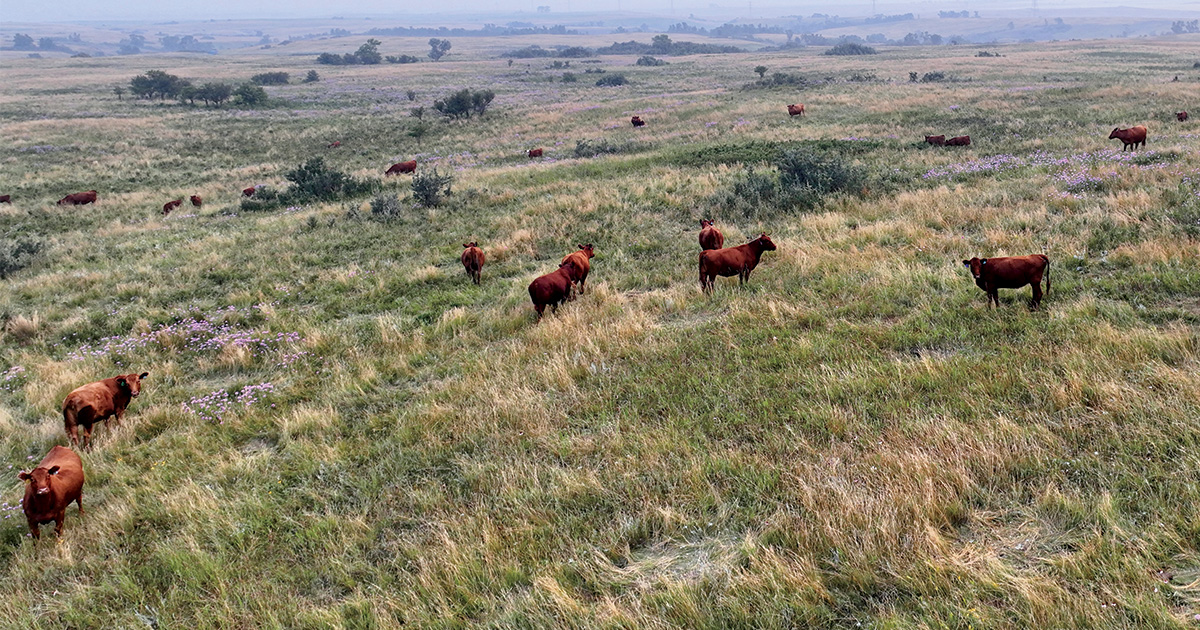
Jay Volk worked with Ducks Unlimited and the USDA Natural Resources Conservation Service to install fencing on his North Dakota ranch. The new infrastructure allows him to move his cattle among a series of pastures, improving forage quality and enhancing crucial upland cover for ducks and other ground-nesting birds.
“This was a monumental moment for DU and for conservation across North America,” says Craig LeSchack, DU national director of conservation. “It is also reflective of DU’s unique way of approaching conservation. Our mission remains laser-focused on conserving wetlands and associated habitats for waterfowl, but we’ve been able to dramatically expand our conservation impact by showing landowners, companies, and communities that conservation is beneficial to their families, livelihoods, communities, and shareholders.”
On the Volk Ranch, every single acre under conservation stewardship is part of a mosaic of vibrant lands—crucial for waterfowl and cattle and local cities and towns—whose effects ripple in every direction. The million acres DU conserved will improve the futures of every species of ducks and geese in North America, from the pintails that stream out of Alaska’s diverse wetlands to fill the skies of California’s Central Valley to the mottled ducks that nest on the soggy cattle pastures of central Florida.
To meet this milestone required a sweeping array of DU partners: farmers and ranchers who were willing to sell conservation easements and partner on habitat improvement projects. Local, state, and federal agencies who rely on DU’s expertise in fundraising and wetland engineering. Corporate and business interests who trust DU’s track record of verifiable conservation success to help them deliver on sustainability goals to shareholders and customers. And it required the entire DU ecosystem to pull in the same direction. In the same way that every acre mattered to the 1-million-acre goal, every DU supporter—from rank-and-file members to volunteers to staff—had a role to play.
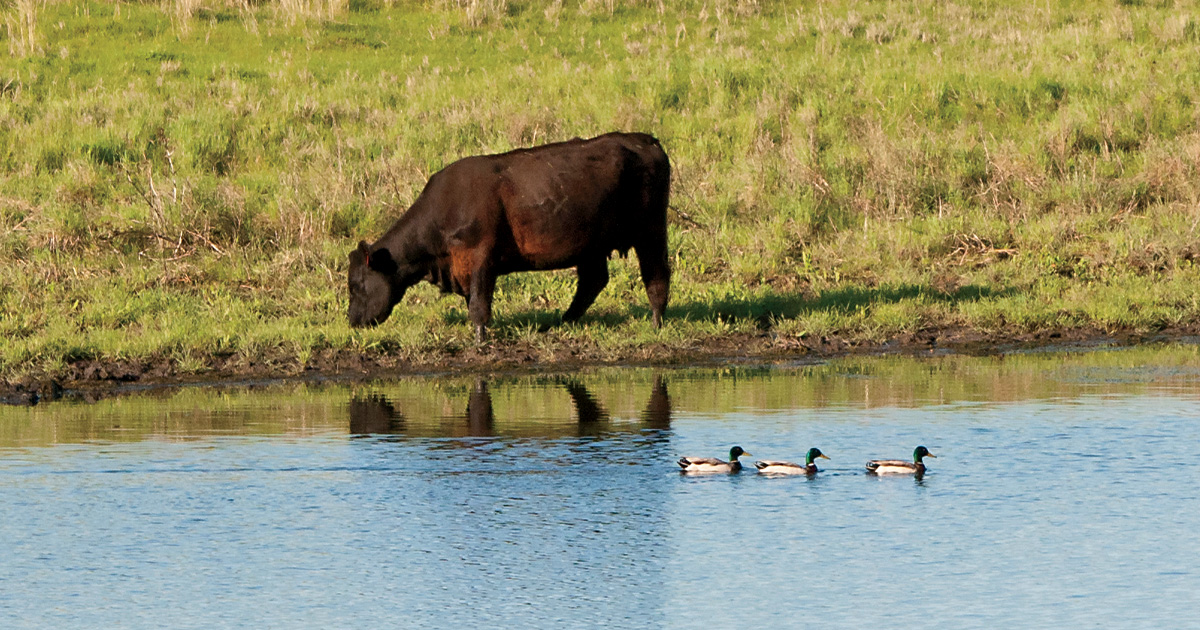
Rotational grazing and other wildlife-friendly agricultural practices conserve crucial waterfowl habitats on working lands.
Volk knew his family had found the perfect partner when he met William Palarski, a conservation programs biologist in DU’s Great Plains Region. Volk and Palarski walked the land. They talked about how Volk’s three girls loved to hunt upland birds on the family ranch. How his wife’s family had homesteaded nearby. It wasn’t all about the dollars. It was about relationships, and vision, and working on a scale that Volk could manage.
“I realized that our core values and DU’s core values aligned,” Volk says. “The approach was never about not using land but using land correctly and managing it correctly. But that takes the proper tools—water, fencing, infrastructure—and for a small operator like me, that wasn’t financially bearable. Working with DU made it all come together.”
The old dam was a mess. Built in 1938 on the Sheboygan River in eastern Wisconsin, it wasn’t designed to allow for meaningful control of water levels in the sprawling marsh it impounded. The result was that the marsh was a mess, too. Instead of lush wet meadows of sedges, rushes, reeds, and wild rice, it had turned into a vast near-monoculture of hybrid cattail. In high-water periods, huge mats of the tall plants would break loose from the marsh and float to the dam, clogging the overflow. In low-water periods, more and more cattails would root and spread. It was a vicious cycle that had turned the beloved 14,000-acre Sheboygan Broughton Marsh from a diverse wetland rimmed in white cedar and tamarack into a $50,000-per-year maintenance headache for local communities. And a hollowed-out refuge for waterfowl.
The solution—a new dam with modern water-management features—involved a wide range of partners: Sheboygan County Planning and Conservation Department, Sheboygan County Conservation Association, Wisconsin Department of Natural Resources, US Fish and Wildlife Service, National Fish and Wildlife Foundation, Fund for Lake Michigan, and Lunda Construction, among others. The project took more than five years to complete, at a cost of some $3.7 million. But when the dam was dedicated this past spring, the nearly 22 square miles of historic Great Lakes wetlands began a new era.
The footprint for the solution? About an acre, give or take. But that acre is another telling example of how DU’s approach to conservation action has evolved.

DU engineers helped design and construct a new dam on Wisconsin’s Sheboygan Broughton Marsh, rejuvenating 22 square miles of historical wetlands on public land.
“Conservation is a team sport,” explains Dr. Karen Waldrop, DU’s chief conservation officer, “especially on the scale we’re now working.” Waldrop remembers when the idea of hitting a mark of a million acres of conservation impact in a single year was introduced to DU’s senior leadership team. “We had a handle on the science of how to have that kind of impact,” she says. “The challenge to increasing acres was to increase funding, increase sponsors, and grow capacity.”
The Sheboygan Broughton Marsh Dam project also reflects an increasingly expansive portfolio of projects rooted in DU’s commitment to sustainability and ecological services initiatives. It’s easy to draw a straight line between more traditional conservation programs such as wetland easements and more ducks in the sky, but working on a million-acre scale required a shift in perspective. DU’s plan was proactive and very much of the moment.
Conservation delivery is not an exact science. Waldrop recalls DU biologists applying for the same federal grants numerous times, failing but learning, employing new approaches on subsequent tries, and ultimately succeeding. It was all a part of a long-term, collaborative strategy. “We all had an attitude of ‘persistence over resistance,’” Waldrop says. “That’s the kind of journey we’ve been on.”
And over the last year, it worked time and time again. To the tune of a million acres.
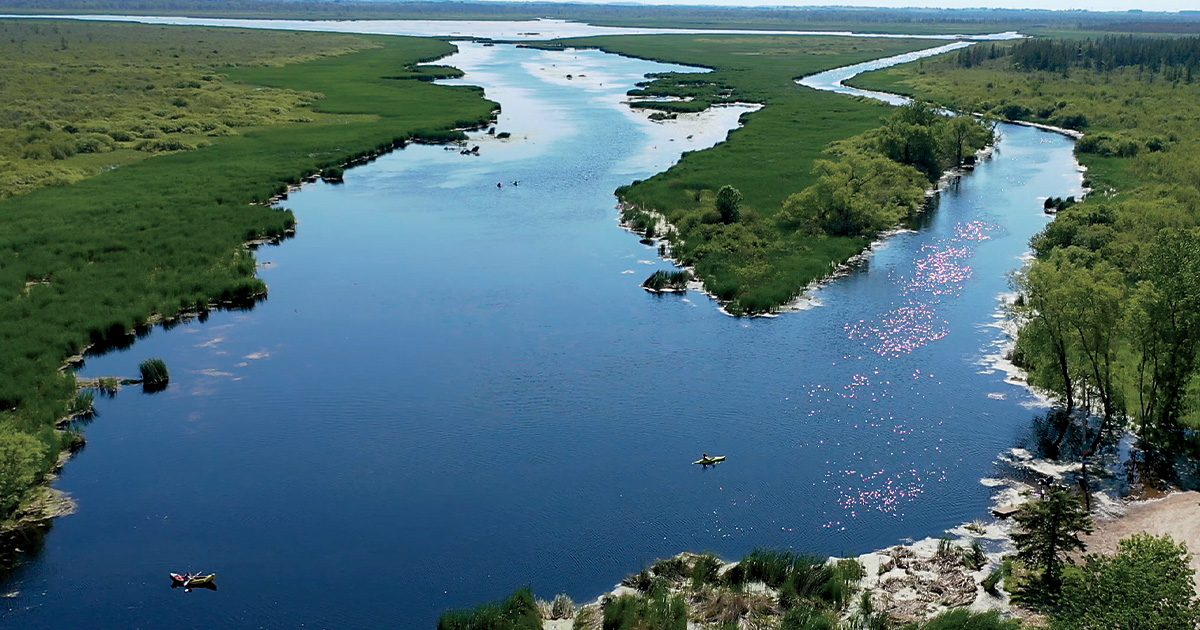
Wisconsin's Sheboygan Broughton Marsh
Deep in the Atchafalaya Basin, where the eponymous river slows and braids into a massive, remote wetland at the edge of the Gulf of Mexico, DU, the Louisiana Department of Wildlife and Fisheries, and the James M. Cox Foundation recently pulled off a project that would have thrilled every little kid in America who loves to play with a toy dump truck: they floated giant excavators on barges and bucket-scooped giant crevasses into the levees and banks that had long stymied water flow through the delta. One of those gaps was carved into Log Island Pass in the Atchafalaya Delta Wildlife Management Area. The finished crevasse is 1,175 feet long and about 50 feet wide.
Its total footprint? Just over 58,000 square feet. An acre, more or less.
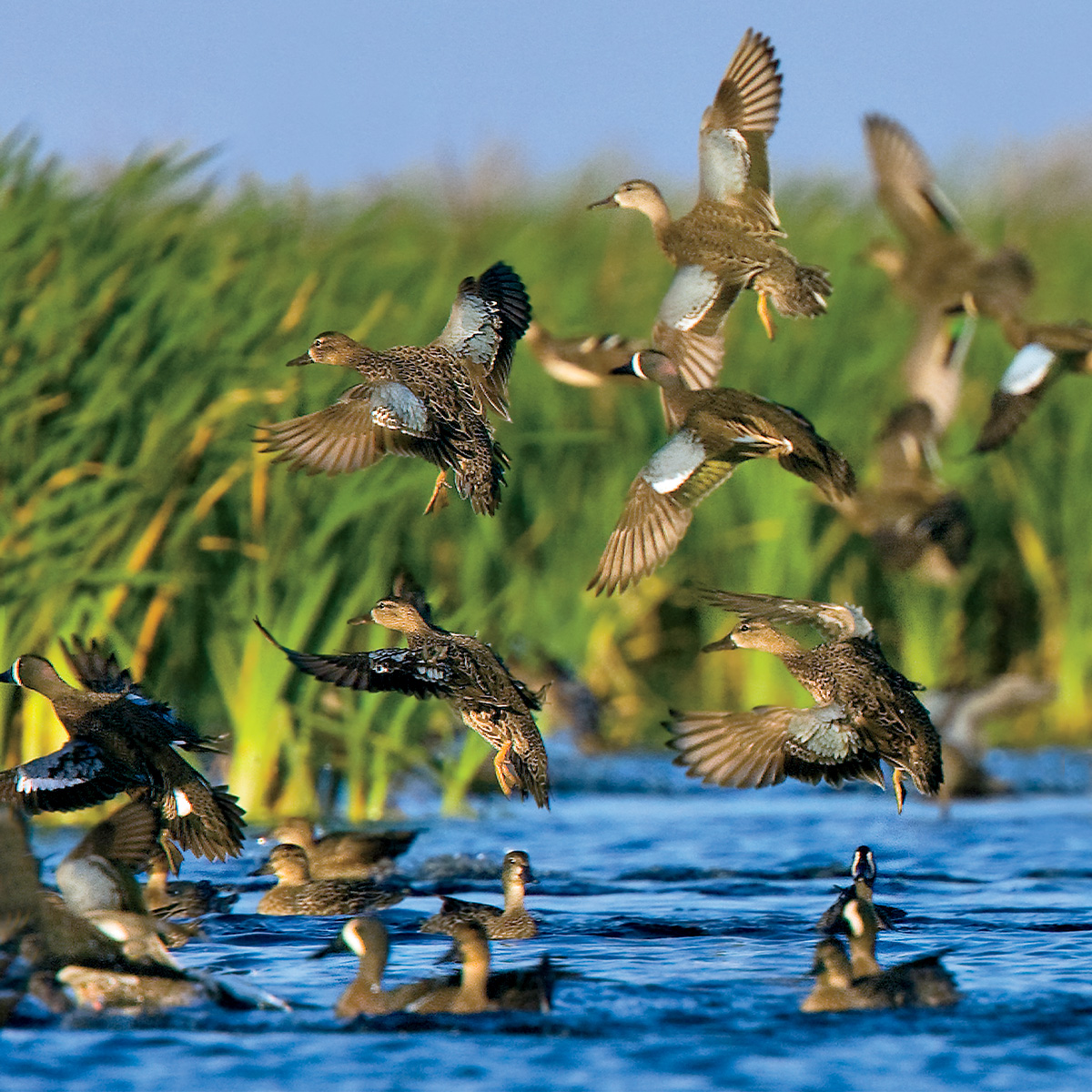
The coastal wetlands of south Louisiana support migrating and wintering blue-winged teal and many other waterfowl species.
But that one-acre breach will unlock the long-stymied natural processes of land-building along Louisiana’s Gulf Coast. River flows will ferry silt and sediments from the Mississippi Alluvial Valley into the delta. New marsh will appear, trapping more sediment and converting open bays into a dynamic system of shallows and troughs, mud banks and marsh. Crabs, redfish, and sometimes speckled trout will follow. Ducks and shorebirds won’t be far behind, and neither will waterfowlers and crabbers and anglers.
“Cut holes in the pass and we’ll let the river run,” explains Cassidy Lejeune, DU director of conservation programs for south Louisiana. “Let nature do her thing.” Like a prairie pothole’s thing is to shelter and sustain a new generation of mallard ducklings. Or an Arkansas rice field’s thing is to provide critical calories for numerous species of migrating and wintering waterfowl and other migratory birds.
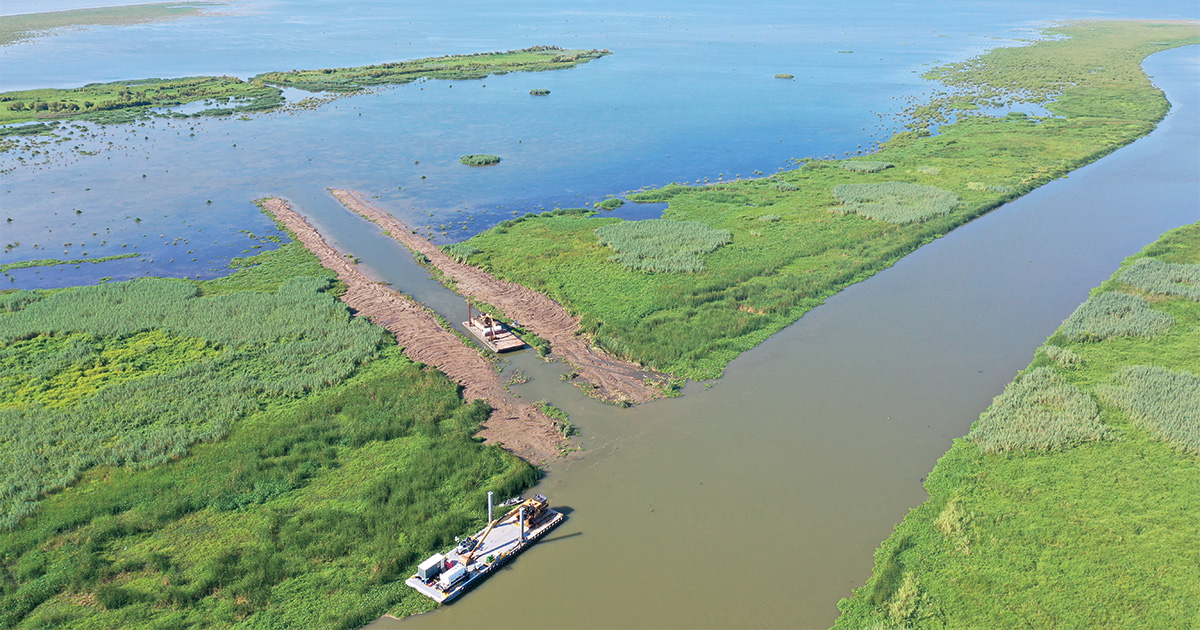
DU recently helped reconnect the Atchafalaya River to a degraded marsh, which will rebuild eroded land and restore habitat for fish and wildlife.
It’s hard to say how much land the Log Island Pass crevasse will ultimately create. Just like it’s difficult to know how many ducks and geese a million acres of conservation will help hatch and fledge, or how much aquifer recharge a million acres of conservation will provide. No one will ever know how many farming and ranching families will stay on the land thanks to conservation easements and sustainable agricultural practices supported by DU.
But it’s easy to see how it all comes together.
One acre at a time.

The Prairie Pothole Region is a biological marvel. Millions of shallow wetlands are set into a vast grassland landscape that unfurls across parts of Minnesota, Iowa, the Dakotas, Montana, Saskatchewan, Manitoba, and Alberta. The region is the highest-priority area on the continent for Ducks Unlimited, and a nursery where, in wet years, the majority of North America’s ducks are raised.
Now it has a level of financial support to match its inspiring scale. At DU’s 87th National Convention in San Diego, a $100 million gift to support conservation in the Prairie Pothole Region was announced in honor of Jim Kennedy, chairman emeritus of Cox Enterprises and chairman of the James M. Cox Foundation. The gift is earmarked for long-term conservation projects in the Prairie Pothole Region of the United States and Canada.
Kennedy is DU’s most generous individual supporter and has been deeply connected to the organization for more than 50 years. His initial involvement was as a local volunteer in the Atlanta area, which sowed the seeds for an evolving commitment in which he has served on DU’s board of directors and as Wetlands America Trust’s founding president.
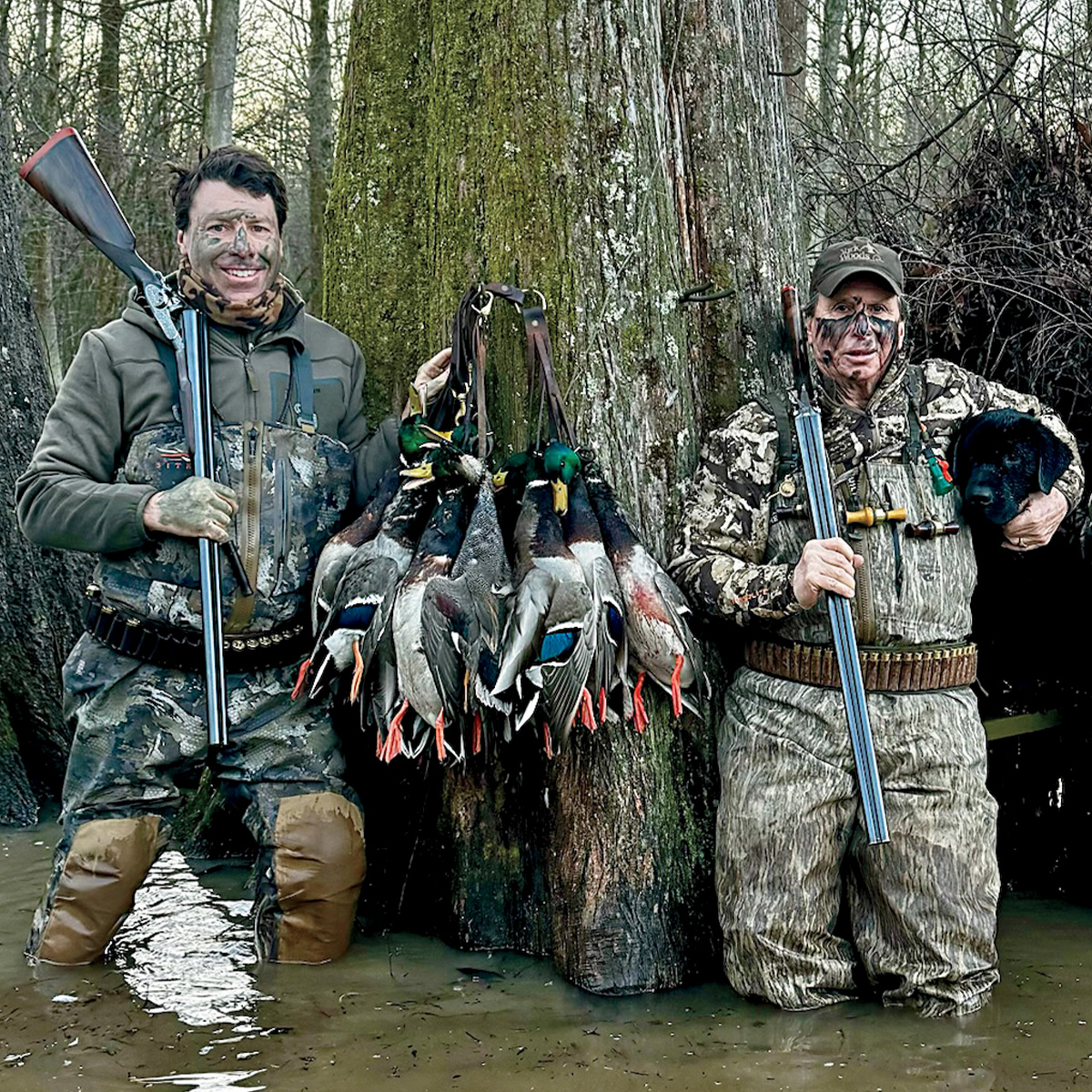
Alex Taylor (left) and Jim Kennedy after a successful duck hunt at York Woods in Mississippi.
“We want to honor Jim and his long legacy of consistent support for conservation,” said Alex Taylor, chairman and CEO of Cox Enterprises. “He has been a leader in waterfowl and wetlands conservation for more than half a century. This gift can only begin to reflect our gratitude for the example he has always set when it comes to showing up and giving back.”
Kennedy’s grandfather, former Ohio Governor James M. Cox, founded Cox Enterprises in 1898. The organization has grown to be the largest private broadband company in the nation, with other divisions centered in the automotive and agriculture industries. Prior to this commemorative gift, Kennedy has supported DU’s work with various personal and corporate gifts of more than $100 million over the years.
The Cox gift is the largest ever bestowed to DU and will be put to near immediate use in those portions of the Prairie Pothole Region identified as capable of supporting up to 100 breeding duck pairs per square mile. The funding will primarily support the purchase of permanent conservation easements from willing landowners.
“If you love ducks and shorebirds and wetlands, this region has to be on the top of the list for conservation action,” Kennedy said. “Land is only going to get more expensive, so we don’t have any time to lose when it comes to the prairie potholes. I’m honored by this gift on my behalf, and I know it will make an impact. But I also hope it inspires others to think about how they can get involved, at whatever level, to conserve our natural heritage.”
Conservation is woven into the historic fabric of Cox Enterprises, Taylor said. “We have a long-standing history of supporting a healthy environment. Doing right for wildlife and healthy habitats is a natural part of our business model.”
DU and Cox Enterprises plan to invest the bulk of the funding within three to four years, supercharging efforts to restore, enhance, and conserve the continent’s most critical breeding grounds for waterfowl. The funds will help support DU’s international fundraising campaign: Conservation for a Continent. Our Wetlands. Our Legacy. The campaign recently surpassed the $2 billion mark of its goal of raising $3 billion by 2026 for DU’s conservation mission.
Ducks Unlimited uses cookies to enhance your browsing experience, optimize site functionality, analyze traffic, and deliver personalized advertising through third parties. By continuing to use this site, you agree to our use of cookies. View Privacy Policy